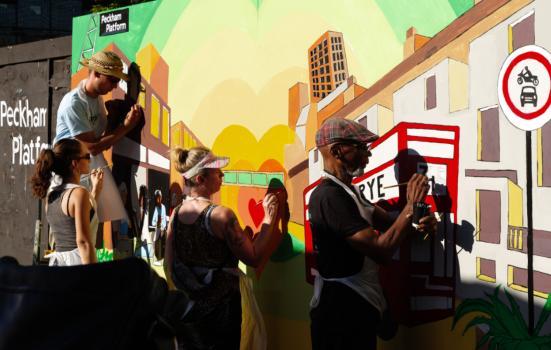Organisations that supported an experimental funding programme say allowing communities to make creative decisions has driven positive change in their local areas.

Anselm Ebule
An evaluation of a funding programme that gave local communities the autonomy to create their own cultural interventions has found creativity “can be a vital tool in helping develop wellbeing within local communities”.
The Creative Civic Change (CCC) funding programme supported 15 communities across England to shape, lead and commission arts and creative works aimed at making positive social change in their local area.
One of the programme’s four funders, Local Trust, published the evaluation into the £4m programme, which ran from October 2018 to 2022.
READ MORE:
- Creating spaces for reflection and connection
- Locally-led arts sustained communities through lockdown
It says that despite much of the activity taking part during the height of the pandemic, CCC was “transformative for people, places, artists and funders”.
The evaluation notes the programme helped to grow connections, confidence, wellbeing, skills and creativity.
Local communities were trusted to make funding decisions, local people with creative skills were given creative opportunities, artists collaborating on the projects became more integrated in their local communities and funders learned to respond flexibly to the way they measured the success of the project.
Final community projects included murals and sensory gardens in housing estates, the setting up of an inclusive youth theatre group and a weekend of events that brought different generations and cultures together.
The National Lottery Community Fund, Esmée Fairbairn Foundation and the Calouste Gulbenkian Foundation funded the programme alongside Local Trust.
“As a funder it has been a privilege to support this transformational programme which has taken such a fresh approach to funding communities,” said Louisa Hooper, Calouste Gulbenkian Foundation Director.
“We have tried hard to give communities the freedom to shape their own creative programmes to meet what they need, not what we think they want.”
“It is great to hear from projects at this event and from the wider evaluation what an impact Creative Civic Change has had, and the power of creativity in building stronger communities.”
Positive outcomes
The evaluation says over 800 artists worked within CCC’s 15 communities, with nearly 80% being locally based.
The majority of those taking part in the project said it helped make creativity more accessible to them, with 89% of community members responding to an end of programme survey stating they felt more creative during the project.
Almost all (97%) of community members surveyed said they felt positive about their involvement, with ‘happy’, ‘proud’ and ‘feeling included’ being the most frequent responses.
Local Trust’s Senior Project Manager for CCC Grace Bremner said the programme enabled many local people with creative skills to see themselves as creatives, artists and leaders.
“It has also changed how many communities look, feel and think about themselves,” she said.
Bremner added the programme helped local artists become more integrated in their communities.
“The CCC approach, with its emphasis on care, support and peer learning, has provided a safe environment to share experiences, looking honestly at what has and hasn’t worked while celebrating success.”
Programme recommendations
Alongside the evaluation, Local Trust published a series of recommendations for those involved in running community-led creative projects.
Its suggestions for similar creative community projects include being experimental, transparent in their expenditure and to prioritise environmentally sustainable practice. They should also create a clear, shared long-term vision and ensure all parts of the community are involved in decision making.
Specific guidance for members of the arts sector states not to dismiss poor neighbourhoods in your local areas and to rethink relationships with community organisations.
The recommendations say funders should ensure funding for creative community projects covers reactive spending as well as core costs, adding that sometimes “the most impactful spend is unplanned and of low monetary value”.
Funders also need to “think longer term”, the recommendations add, stating the minimum time for a programme similar to CCC is three years if it is to be successful.
Hooper said providing funding to CCC meant the Calouste Gulbenkian Foundation had to “learn to let go more than funders often do and not be too prescriptive about our funding outcomes”.
“Giving communities six months at the start of their programmes to work out what they really wanted was a key success factor and meant that projects didn’t just dive straight in but had considered and consulted widely.”




